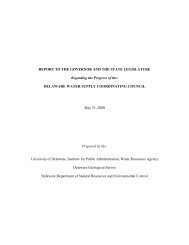Water Quality Trading in the Lower Delaware River Basin: A ...
Water Quality Trading in the Lower Delaware River Basin: A ...
Water Quality Trading in the Lower Delaware River Basin: A ...
You also want an ePaper? Increase the reach of your titles
YUMPU automatically turns print PDFs into web optimized ePapers that Google loves.
impaired segment at PSA with <strong>the</strong> o<strong>the</strong>r sources. But, trades <strong>in</strong>volv<strong>in</strong>g PSB and PSC<br />
would require ano<strong>the</strong>r step. If PSB wanted to purchase a reduction from PSC, modelers<br />
would need to apply <strong>the</strong> trad<strong>in</strong>g ratio <strong>in</strong> series from PSB to PSA and <strong>the</strong>n PSA to PSC.<br />
PSB would need to purchase two units to account for equivalency between PSB and PSA<br />
and 1/3 of a unit to account for equivalency between A and C. The result<strong>in</strong>g trad<strong>in</strong>g ratio<br />
is 0.66, <strong>the</strong> product of 2 and 1/3. TMDL modelers could perform a model run for unit<br />
loads at each PS and produce a matrix of trad<strong>in</strong>g ratios for <strong>the</strong> trad<strong>in</strong>g system (Table 2.5).<br />
Table 2-5. Sample Matrix of <strong>Trad<strong>in</strong>g</strong> Ratios for Po<strong>in</strong>t Sources<br />
Buyers<br />
Sellers<br />
PSA PSB PSC<br />
PSA 1 1/2 1/3<br />
PSB 2 1 2/3<br />
PSC 3 3/2 1<br />
The development of a matrix of trad<strong>in</strong>g ratios for a system of PS is a manageable<br />
endeavor. First, <strong>the</strong> PS discharges have little uncerta<strong>in</strong>ty. Therefore, <strong>the</strong> trad<strong>in</strong>g ratio is a<br />
function of <strong>the</strong> decay, transformation, and advective removal <strong>in</strong> <strong>the</strong> waterway. Eng<strong>in</strong>eers<br />
can quantify this effect with ease and accuracy relative to <strong>the</strong> o<strong>the</strong>r aspects of model<strong>in</strong>g.<br />
Second, <strong>the</strong> number of model runs that <strong>the</strong> system requires for determ<strong>in</strong><strong>in</strong>g<br />
trad<strong>in</strong>g ratio is manageable. A system with N prospective traders would require N x (N-<br />
1) trad<strong>in</strong>g ratios. For a trad<strong>in</strong>g system, like a system for low-flow TMDL on <strong>the</strong><br />
Christ<strong>in</strong>a <strong>Water</strong>shed, only a handful of model runs are required because <strong>the</strong>re are only a<br />
handful of PS. Fur<strong>the</strong>rmore, <strong>the</strong> hydrologic attributes of <strong>the</strong> waterway may create a<br />
system <strong>in</strong> which two PS buy from and sell to each o<strong>the</strong>r at reciprocal ratios (as shown <strong>in</strong><br />
Table 2-5). If this condition holds, modelers need only perform one model run for each<br />
prospective PS trader. They can deduce all o<strong>the</strong>r values of trad<strong>in</strong>g ratio from <strong>the</strong>se<br />
results.<br />
Third, even if <strong>the</strong> system has a large geographic area and a large number of<br />
potential participants, modelers can take reasonable steps to simplify <strong>the</strong> development of<br />
trad<strong>in</strong>g ratios. Imag<strong>in</strong>e a system with hundreds of prospective traders. It could require<br />
thousands of model runs to determ<strong>in</strong>e all of <strong>the</strong> trad<strong>in</strong>g ratios. This task may be<br />
problematic due to high cost and time requirements. Instead, modelers can divide <strong>the</strong><br />
waterways <strong>in</strong> <strong>the</strong> bas<strong>in</strong> <strong>in</strong>to a manageable number of segments and perform an analysis<br />
for each stream segment. Application of this step can reduce <strong>the</strong> number of model runs<br />
from thousands or hundreds to hundreds or dozens.<br />
While <strong>the</strong> determ<strong>in</strong>ation of trad<strong>in</strong>g ratios is technically manageable, <strong>the</strong>y can also<br />
be challeng<strong>in</strong>g. First, <strong>the</strong> specific ratios that <strong>the</strong> model runs determ<strong>in</strong>e apply only to <strong>the</strong><br />
specific arrangement of loads that <strong>the</strong> model used to determ<strong>in</strong>e <strong>the</strong>se ratios. If trad<strong>in</strong>g<br />
produced a significant redistribution of loads <strong>in</strong> <strong>the</strong> watershed, exist<strong>in</strong>g trad<strong>in</strong>g ratios<br />
would no longer def<strong>in</strong>e equivalency. Similarly, background changes could also change<br />
<strong>the</strong> ratios that <strong>the</strong> system requires for equivalency. System designers can account for<br />
<strong>the</strong>se issues by apply<strong>in</strong>g a marg<strong>in</strong> of safety or re-comput<strong>in</strong>g trad<strong>in</strong>g ratios with an<br />
appropriate periodicity. A logical time to reconfigure <strong>the</strong> trad<strong>in</strong>g ratios is dur<strong>in</strong>g renewal<br />
of <strong>the</strong> permit.<br />
29




